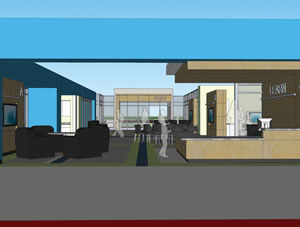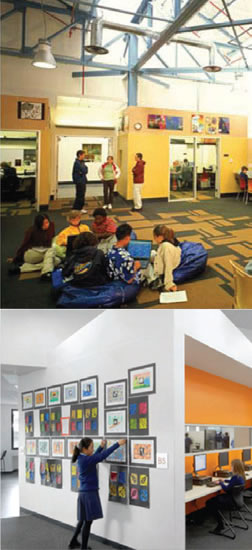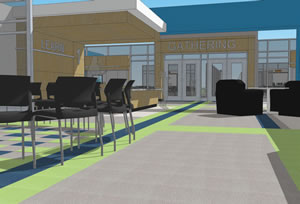Fulfilling a Primary Need

IMAGE COURTESY OF MOSELEY ARCHITECTS
The school library has become a gathering place to learn, work, and socialize. It has evolved into a media center, study hall, extended learning area, meeting space and place for peer tutoring. Each scenario has a common denominator: technology.
With technology advancing at a rapid rate, some educators believe that the physical library should be phased out and replaced with a digital library that can be accessed in common areas throughout the school. Whether you’re an advocate for a physical library or a digital one, it’s wise to repurpose your school library for the future. Consider these five elements in your 21st-century library: skills, spaces, furniture and equipment, aesthetics and resources.
The 21st-century library must support and reinforce the skills that K-12 students develop to become lifelong learners. The first and most important skill is research in the cyber world. Students must be able to filter, refine and assess their findings, differentiate facts from opinions, and deploy higher-level thinking. In this real-time, on-demand world, students are expected not only to consume content quickly but also create and edit it accurately. All of these skills must be woven into interdisciplinary and problem- and project-based learning. The 21st-century school library must support a flipped curriculum and objective-based learning.

IMAGES COURTESY OF DEJONG-RICHTER
Quiet space? The role of the school library has changed over the past few decades. An area that was once required to be kept as quiet as possible may now have background music and even have areas where audio presentations are taking place. Libraries also now serve as collaboration spaces, so furnishings serve a different role than they did in the past and need to be movable and flexible.
The 21st-century library is much more than a storytelling center in elementary schools or a book warehouse in middle and high schools. The spaces required by a 21stcentury library must support presentation, projection and recording. Spaces must also support individual, small-group and large-group teaching and learning. If possible, include an outdoor space where students can gather to read and relax. Start planning your library space by creating a list of the activities that will take place there.
The furniture and equipment in a 21st-century school library must be mobile, varied and flexible. Furniture should include comfortable seating areas and writable surfaces, including walls, tables and interactive whiteboards. Furniture must also tolerate spills and be sanitized on a regular basis. Equipment should be available for projecting, recording and printing content. Some educators opt for electronic gaming equipment to reinforce learning through play. Many school libraries are becoming shared with public libraries; therefore, it might be worth pursuing a “book–bot” for electronic book storage and delivery.
The aesthetics of a 21st-century school library are key. To fully engage the senses, you must create a feeling of inspiration, interaction and collaboration through natural sunlight, color, texture and artwork created by students and staff. Sound plays an important role. Some students require quiet while they work while others need music to fully engage in their studies. It is especially important at the primary level to take a multi-sensory approach to books. Students should hear the sound of the ocean when reading and learning about whales.
The 21st-century library must also offer multiple resources to support teaching and learning. Resources range from electronic documents, books, music and film to the e-readers, laptops and notebook computers used to access them. It’s also important to provide the 21st-century school library with enough power to support these resources. A few wall sockets aren’t enough. Multi-outlet, mobile power sources are better because they can move as students and resources move through the space. Also consider adding a private cloud solution to get the benefits of public cloud computing, such as self-service, scalability and elasticity, combined with the security and customization your school or district needs.

IMAGE COURTESY OF MOSELEY ARCHITECTS
School libraries, whether they are physical places or digital spaces, will always fulfill a primary need: access to resources that support teaching and learning. How you design them is up to you. Begin by assessing your curriculum and district resources to determine what’s best for your students.
This article originally appeared in the issue of .
About the Author
Kerrianne Wolf, REFP, is the director of Educational Specifications for DeJONG-RICHTER in Dublin, Ohio. She has served as an educational planner for more than 11 years and holds an Ohio teaching license for gifted and talented education in grades K-12 and elementary education in grades 1-8.